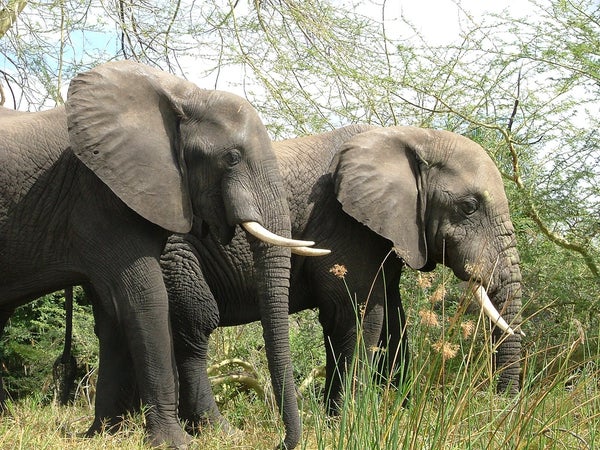This article was published in Scientific American’s former blog network and reflects the views of the author, not necessarily those of Scientific American
The U.S. Fish and Wildlife Service today announced that it will consider African elephants, seven pangolin species, two bee species and two fish for protection under the Endangered Species Act.
African elephants are currently listed as a threatened species. In response to two petitions from conservation groups, FWS will now consider changing their status to endangered, the next worst step beyond threatened. The agency will also, finally, consider listing African elephants as two species, the forest elephant (Loxodonta cyclotis) and savannah elephant (L. africana), a taxonomic change that was formalized a few years ago. Conservationists estimate that nearly 100 elephants are killed by poachers every day for their valuable ivory.
Protecting the African elephant as two species would not only offer more flexibly conservation actions, it could also help to enhance our greater understanding of the endangered pachyderms. “Splitting the two species would certainly draw more attention to the crisis in Central Africa,” says Tara Easter, a scientist with the Center for Biological Diversity, one of the petitioning organizations. “That would in turn provide more funding for actions specifically targeted for forest elephants or savannah elephants, which are facing different threats beyond the overall demand for ivory. Plus, there is so much we don’t know about forest elephants that we do for the more easily-observable savannah elephant.”
On supporting science journalism
If you're enjoying this article, consider supporting our award-winning journalism by subscribing. By purchasing a subscription you are helping to ensure the future of impactful stories about the discoveries and ideas shaping our world today.
FWS also agreed to consider listing the Chinese pangolin (Manis pentadactyla), giant ground pangolin (Smutsia gigantean), Indian pangolin (M. crassicaudata), long-tailed pangolin (Phataginus tetradactyla), Philippine pangolin (M. culionensis), Sunda pangolin (M. javanica) and tree pangolin (P. tricuspis) as endangered species. Currently just one of the eight pangolin species, the Temminck’s ground pangolin (S. temmincki), is protected by the ESA. Pangolins are among the most heavily trafficked animals on the planet.
Protecting these international species under U.S. law is important because Americans are big buyers of illegal wildlife products, including both ivory and pangolin-derived “medicines.” “The U.S. is a destination for parts and products of poached pangolins,” Teresa M. Telecky, Ph.D., director of the wildlife department at Humane Society International, said in a prepared statement. “In 2014, authorities seized more than 11 kilograms of traditional Asian medicines containing pangolin, and seized an additional 460 individual medicine containers that also had pangolin parts. Our research shows that these products are sold here in the U.S. both online and in stores. Listing all pangolin species as Endangered will end the role of the United States in this harmful trade.”
Also on today’s list of species that FWS says may deserve ESA protection: the western bumblebee (Bombus occidentalis), the yellow-banded bumblebee (B. terricola), the Rio Grande chub (Gila pandora), Rio Grande sucker (Catostomus plebeius), and a plant called the Leoncita false-foxglove (Agalinis calycina).
FWS also agreed to consider petitions to remove three species from the ESA: the American burying beetle (Nicrophorus americanus), the Deseret milkvetch (Astragalns desereticns) and the southwestern willow flycatcher (Empidonax traillii extimus). Petitions to delist those species came from the energy, construction and ranching industries.
On top of all of this, FWS found that an additional 15 petitions did not present enough information to take action. Those would have addressed protections for the Acuna cactus, Arizona night lizard, Arizona wetsalts tiger beetle, Bezy's night lizard, Cheoah bald salamander, Cow Knob salamander, MacDougal's yellowtops, Monito skink, Navasota ladies-tresses, Patagonia eyed silkmoth, reticulate collared lizard, South Mountain gray-cheeked salamander and southern dusky salamander.
This is just the first step in the process for all of these species. FWS will now collect public comments for the next 60 days, after which it will begin a formal 12-month review to determine if Endangered Species Act protection is warranted.
